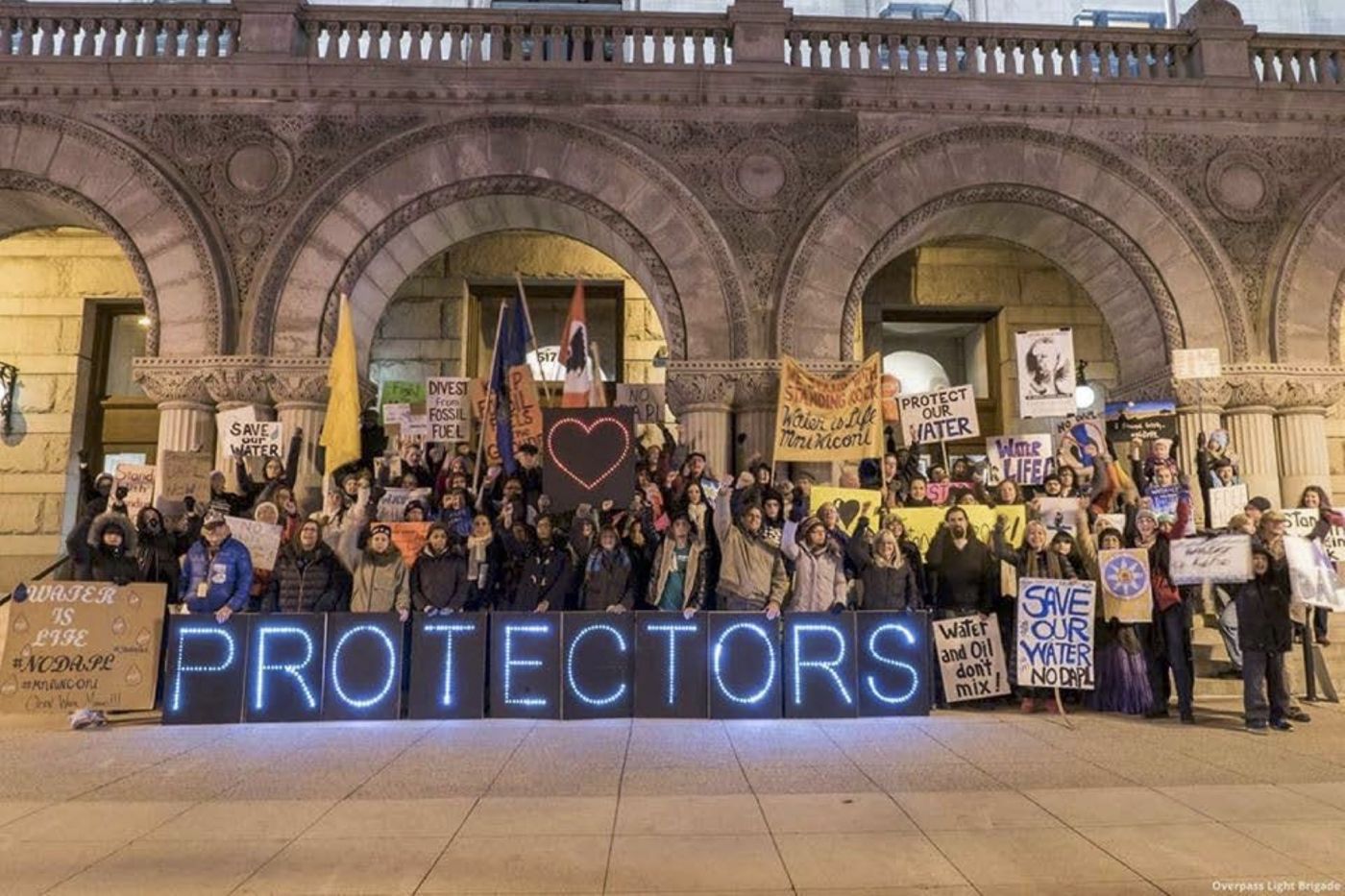Florida's Water Protectors
News about President Trump’s executive orders encouraging the advancement of the Keystone XL and Dakota Access pipelines were a hard hit to all those who have been fighting to keep pipes carrying oil and natural gas out from under their land. Due to the perseverance of water protectors such as those at Standing Rock, these pipeline protests have gotten a lot of press. Yet halfway across the country there is a just as important fight taking place to impede the construction of an approximately 515-mile natural gas pipeline that would run from Alabama to Florida, passing through Georgia.
The pipeline, called Sabal Trail, is a $3.2 billion project that will eventually carry 1 billion cubic feet of natural gas each day. Due to Florida’s unique geology of underwater caves and porous limestone bedrock, known as karst, environmentalists are particularly worried about the potential for spreading if a leak were to occur. The karst bedrock has large voids in its structure and is therefore prone to sinkholes, which opponents of the Sabal Trail pipeline call high risk zones. Should the ground beneath them give way due to an invasion from the pipeline, gas leakages or explosions would contaminate entire limestone regions, says Fractracker.
A cooperation between Spectra Energy Corp. NextEra Energy, Inc. and Duke Energy, it is not surprising that the Sabal Trail LLC fails to mention any aspect of environmental or residential impact by the pipeline on its homepage, instead focusing on the monetary gain of the project. The Sabal Trail Transmission website describes the project as an economic stimulus for the Southeast US, particularly Alabama, Florida, and Georgia, which “will bring additional affordable, clean natural gas supplies to Florida, while increasing the reliability of the region’s energy delivery system and positively impacting the economy.”
According to the U.S. Department of Energy, 1.3 million gallons (4.9 million liters) of petroleum are spilled into U.S. waters from vessels and pipelines in a typical year. Now let us remember that that is just an average, and only include pipelines that transport petroleum. Indeed, EcoWatch reports that since 2006, 3,032 incidences that amounted to $4.7 billion of damages were reported. The Pipeline and Hazardous Materials Safety Administration (PHMSA) published last October that there had been 220 “significant” pipeline incident reports so far in 2016. “Serious Incidents” included a fatality or injury requiring in-patient hospitalization, costs of more than $50,000, releases of more than five barrels of volatile fluids such as gasoline or 50 barrels of other liquids, or a fire or explosion. With that definition, we know that 220 incidents is only a percentage of the number of actual pipeline accidents per year. PHMSA data showed that the number of significant pipeline incidents grew 26.8% from 2006 to 2015.
So the overwhelming doom from news of another incoming pipeline and consequential fierce protesting that many communities are undergoing to cease construction makes very much sense when we look at the numbers for the risk involved with pipelines. Not only does the actual construction fell forests, impede rivers, destroy topsoils, devastate habitats and private properties.The damage is not done once the pipeline has made its presence permanent.The fear of a leak, resulting in dangerous habitat and water contamination around the area, is even more permanent. Pipeline companies, although often advertised as claiming accountability in clean-up procedures for these spills, cannot deny the fact that were the pipeline nonexistent, the subsequent leakage and clean up would be unnecessary.
Another controversial aspect of the pipeline construction dates back to a ruling passed in June, 2005 from the Supreme Court called eminent domain. The Washington Post explained that the the ruling gave local governments the power to force property owners to sell out and make way for private economic development when officials decide it would benefit the public, even if the property is not blighted and the new project's success is not guaranteed. At the time the ruling came about because of the need for “urban revitalization” in towns and cities and the court was in favor of it 5 to 4.
But Justice Sandra Day O'Connor anticipated the impact that it might have on small land owners and elderly and low income residents. She wrote that the ruling favors the most powerful and influential in society and leaves small property owners little recourse. Now, she wrote, the "specter of condemnation hangs over all property. Nothing is to prevent the State from replacing any Motel 6 with a Ritz-Carlton, any home with a shopping mall, or any farm with a factory."
And that is exactly what is happening with the case of the Sabal Trail Pipeline and the Bell Brothers. The Federal Energy Regulatory Commission (FERC) used this ruling to grant eminent domain to the companies building the project through seized private property. This included the land that the Bell brothers inherited from their mother.
James Bell is one of the people who is fighting the presence of the pipeline on his land. He and his brother sued Spectra Energy against Sabal Trail’s eminent domain lawsuit and their countersuit for criminal trespass. Unfortunately, the judge did not rule in their favor, and in addition added $47,000 to the Bell Brothers’ bill, making them responsible for paying back Sabal Trail’s attorney fees.
"In my personal opinion I don’t see how a private for-profit company should be allowed eminent domain…I might understand it if it was for the greater good of the country but this is not,” said Bell.
He and his brother started a GoFundMe campaign to help them pay for the $47,000 in fees that they now owe Sabal Trail. They feel that Spectra Energy is trying to set a precedent, saying “Don’t mess with us.” Why else would the company go to such means, asks Bell. “I don’t understand why a billion dollar company doing a two to three billion dollar project needs $47,000? From average, ordinary, tax paying citizens who are doing nothing more than defending their rights as they see it,” said James Bell.
This land rights injustice is hardly a singular case, and although all federal permits for the pipeline construction are in place, the Sierra Club, the Gulf Restoration Network, and Flint Riverkeeper are challenging that permitting process with a joint lawsuit in order to support small landowners.
Aside from the legal ongoings of the pipeline, activists have taken the stage along various strategic construction points and there are several camps where water protectors have gathered together to make their voices heard by construction crews and local authorities.
Fractracker reports that “Along the Suwannee River in Florida, peaceful protesters have assembled at the Sacred Waters encampment and, on November 12, 2016, faced off with authorities in an effort to stop pipeline drilling under the Santa Fe River between Branford and Fort White, Florida. 14 people were arrested in that protest. Demonstrations at the site continue, with a dawn march and demonstration that began just after sunrise on November 26th. No arrests were made on that day. Another protest encampment, the Crystal Waters Camp, is also in place near Fort Drum, Florida, where observers noted hydrocarbon releases from the pipeline construction into Fort Drum Creek and destruction of wildlife by a pipeline crew. Still other protests about the potential environmental risks posed by the Sabal Trail have taken place recently in both Orlando and Live Oak, Florida.”
John Quarterman, president of the WWALS Watershed Coalition that advocates for the conservation of five rivers in Georgia and Florida, including the Suwannee says there is a strong community fighting peacefully to protect the region. “This is our land and our water, not theirs. We can’t just sit here and let them come through here. We have to do something about it.”
I spoke with two water protectors who are living at the Sacred Water Camp at the Suwannee River, east of US 129 in Suwannee County, FL. One young man, who goes by the name Red and came from Port Richey in Pasco County, has been at the camp since December. The goal of his presence at the camp is to inform the people at the top like Governor Rick Scott and the Rockefeller oil industry that he and others “refuse to exist idly by in apathy while we are put at the huge risk of water contamination for the reward of multi-billion dollar industries.” He explained what a day in the life of a water protector at the camp might look like, saying that they organize various non-violent actions that range from "non-arrestable" (like prayer, singing, chanting, holding signs and keeping the mood up) to "arrestable" (things like locking themselves to equipment and stopping construction until they're cut from them and arrested). When I questioned him about how he has been treated by the local authorities in charge of carrying out the pipeline constructions, he said it really depends on the officer. “One dragged me to the car when I was arrested, while I shared good conversation with the officer who transported me to jail.”
I asked Red what message he would like to convey to the public, perhaps those who would like to support the anti-pipeline movement but cannot themselves make the commitment to be water protectors. He responded quickly. “Divest. Divest. Divest. This pipeline is being funded by banks like Wells Fargo and Bank of America using people's' money without their knowledge.”
Chester Roaming Wolf Rice is one of the leaders at Suwanee’s Sacred Water Camp. Originally from Ohio, he has a strong connection to Florida because of its unique ecosystems and because his daughter was born there. Once a member of the US Armed Forces, Rice is considered a spirit walker at the camp and undertakes the task of keeping the protests peaceful. He agreed somewhat with Red, saying that the local county sheriff's department has been “really extremely nice,” but that he feels that arrests like Red’s are a contradiction of “our constitutional right to protest peacefully.” He urges people to contact Congress and their Governors in Florida as well as other states to complain about this breach of the constitution.
Reflecting on his sworn oath to uphold the Constitution against foreign or domestic threats as a member of the army, Rice says that for him it’s more than a battle to save the environment, it's a battle to save people's constitutional rights which are slowly being taken away. “From this day forward it's no longer about just water protection.The actions are now for the freedom of people here in the United States.”
And, I would add, the freedom of life besides humans.
Sources: PHMSA, EcoWatch, Sabal Trail LLC, On the Lake Front Blog, The Washington Post, DeSmog Blog, Fractracker, WWALS, Facebook Sacred Water Camp, The Guardian










